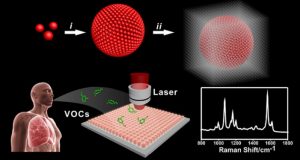
According to the World Cancer Report from the World Health Organization (WHO) in 2014, cancer-related deaths are predicted to rise from an estimated 8.2 million annually to 13 million per year by 2030. Lung cancer is one of the leading causes of cancer death (19.4%).
However, survival rates can vary widely, depending on how far the cancer has spread at the time of diagnosis. Early diagnosis can make a big difference. There is a great need to develop a technology that makes the lung cancer detection cheap, portable, programmable, and easy to use.
In a communication in Advanced Materials, Prof. Tie Wang and his colleagues from Institute of Chemistry (CAS), China, present a biosensor based on SERS technique to detect lung cancer volatile organic compound (VOC) from exhaled breath. SERS is a powerful analytical technique that provides fingerprint molecular information with excellent sensitivity. The analysis of VOC is a relatively new strategy for screening and diagnosing disease, which is convenient, non-invasive, and well-tolerated by patients.
In this study, a specific core–shell 3D structure (GSPs@ZIF-8) is constructed as the SERS substrate, wherein ordered gold superparticles (GSPs) act as SERS hotspots and metal organic framework (MOF) slow the flow rate and therefore enhance the adsorption of gaseous analyte. Immunohistochemical analysis of clinical specimens from lung cancer patients and controls show that expression of aldehyde dehydrogenase 1 is positively correlated with the stage and grade of lung tumors and related to a poor prognosis for the patients with early-stage lung cancer. Therefore, they selected gaseous aldehydes in exhaled breath as target molecule to selectively captured in the GSP substrates.
Transport model of gaseous molecules in porous media was changed because of the collisions between gas molecules and the porous media as directly evidenced by total internal reflection fluorescence micrographs, which is the first evidence of our eyes telling a similar liquid-transportation behavior of gaseous molecules under conditions of normal pressure and temperature. Accordingly, the SERS signal of 4-ATP exhibits remarkable changes in response to aldehyde VOCs down to the ppb (parts per billion) level even in a complex VOCs system.
This approach has the potential to be transformed into a highly sensitive and specific point of care diagnostic tool for early detection of lung cancer.

















